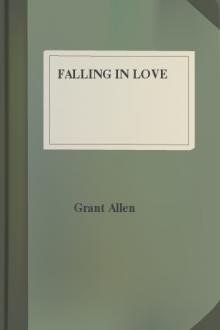Falling in Love by Grant Allen (different e readers .txt) 📕

- Author: Grant Allen
- Performer: -
Book online «Falling in Love by Grant Allen (different e readers .txt) 📕». Author Grant Allen
In our very varied modern societies, every man and every woman, in the upper and middle ranks of life at least, has an individuality and an idiosyncrasy so compounded of endless varying stocks and races. Here is one whose father was an Irishman and his mother a Scotchwoman; here is another whose paternal line were country parsons, while his maternal ancestors were city merchants or distinguished soldiers. Take almost anybody's 'sixteen quarters'—his great-great grandfathers and great-great grandmothers, of whom he has sixteen all told—and what do you often find? A peer, a cobbler, a barrister, a common sailor, a Welsh doctor, a Dutch merchant, a Huguenot pastor, a cornet of horse, an Irish heiress, a farmer's daughter, a housemaid, an actress, a Devonshire beauty, a rich young lady of sugar-broking extraction, a Lady Carolina, a London lodging-house keeper. This is not by any means an exaggerated case; it would be easy, indeed, from one's own knowledge of family histories to supply a great many real examples far more startling than this partially imaginary one. With such a variety of racial and professional antecedents behind us, what infinite possibilities are opened before us of children with ability, folly, stupidity, genius?
Infinite numbers of intermixtures everywhere exist in civilised societies. Most of them are passable; many of them are execrable; a few of them are admirable; and here and there, one of them consists of that happy blending of individual characteristics which we all immediately recognise as genius—at least after somebody else has told us so.
The ultimate recipe for genius, then, would appear to be somewhat after this fashion. Take a number of good, strong, powerful stocks, mentally or physically, endowed with something more than the average amount of energy and application. Let them be as varied as possible in characteristics; and, so far as convenient, try to include among them a considerable small-change of races, dispositions, professions, and temperaments. Mix, by marriage, to the proper consistency; educate the offspring, especially by circumstances and environment, as broadly, freely, and diversely as you can; let them all intermarry again with other similarly produced, but personally unlike, idiosyncrasies; and watch the result to find your genius in the fourth or fifth generation. If the experiment has been properly performed, and all the conditions have been decently favourable, you will get among the resultant five hundred persons a considerable sprinkling of average fools, a fair proportion of modest mediocrities, a small number of able people, and (in case you are exceptionally lucky and have shuffled your cards very carefully) perhaps among them all a single genius. But most probably the genius will have died young of scarlet fever, or missed fire through some tiny defect of internal brain structure. Nature herself is trying this experiment unaided every day all around us, and, though she makes a great many misses, occasionally she makes a stray hit and then we get a Shakespeare or a Grimaldi.
'But you haven't proved all this: you have only suggested it.' Does one prove a thesis of deep-reaching importance in a ten-page essay? And if one proved it in a big book, with classified examples and detailed genealogies of all the geniuses, would anybody on earth except Mr. Francis Galton ever take the trouble to read it?
DESERT SANDSIf deserts have a fault (which their present biographer is far from admitting), that fault may doubtless be found in the fact that their scenery as a rule tends to be just a trifle monotonous. Though fine in themselves, they lack variety. To be sure, very few of the deserts of real life possess that absolute flatness, sandiness and sameness, which characterises the familiar desert of the poet and of the annual exhibitions—a desert all level yellow expanse, most bilious in its colouring, and relieved by but four allowable academy properties, a palm-tree, a camel, a sphinx, and a pyramid. For foreground, throw in a sheikh in appropriate drapery; for background, a sky-line and a bleaching skeleton; stir and mix, and your picture is finished. Most practical deserts one comes across in travelling, however, are a great deal less simple and theatrical than that; rock preponderates over sand in their composition, and inequalities of surface are often the rule rather than the exception. There is reason to believe, indeed, that the artistic conception of the common or Burlington House desert has been unduly influenced for evil by the accessibility and the poetic adjuncts of the Egyptian sand-waste, which, being situated in a great alluvial river valley is really flat, and, being the most familiar, has therefore distorted to its own shape the mental picture of all its kind elsewhere. But most deserts of actual nature are not all flat, nor all sandy; they present a considerable diversity and variety of surface, and their rocks are often unpleasantly obtrusive to the tender feet of the pedestrian traveller.
A desert, in fact, is only a place where the weather is always and uniformly fine. The sand is there merely as what the logicians call, in their cheerful way, 'a separable accident'; the essential of a desert, as such, is the absence of vegetation, due to drought. The barometer in those happy, too happy, regions, always stands at Set Fair. At least, it would, if barometers commonly grew in the desert, where, however, in the present condition of science, they are rarely found. It is this dryness of the air, and this alone, that makes a desert; all the rest, like the camels, the sphinx, the skeleton, and the pyramid, is only thrown in to complete the picture.
Now the first question that occurs to the inquiring mind—which is but a graceful periphrasis for the present writer—when it comes to examine in detail the peculiarities of deserts is just this: Why are there places on the earth's surface on which rain never falls? What makes it so uncommonly dry in Sahara when it's so unpleasantly wet and so unnecessarily foggy in this realm of England? And the obvious answer is, of course, that deserts exist only in those parts of the world where the run of mountain ranges, prevalent winds, and ocean currents conspire to render the average rainfall as small as possible. But, strangely enough, there is a large irregular belt of the great eastern continent where these peculiar conditions occur in an almost unbroken line for thousands of miles together, from the west coast of Africa to the borders of China: and it is in this belt that all the best known deserts of the world are actually situated. In one place it is the Atlas and the Kong mountains (now don't pretend, as David Copperfield's aunt would have said, you don't know the Kong mountains); at another place it is the Arabian coast range, Lebanon, and the Beluchi hills; at a third, it is the Himalayas and the Chinese heights that intercept and precipitate all the moisture from the clouds. But, from whatever variety of local causes it may arise, the fact still remains the same, that all the great deserts run in this long, almost unbroken series, beginning with the greater and the smaller Sahara, continuing in the Libyan and Egyptian desert, spreading on through the larger part of Arabia, reappearing to the north as the Syrian desert, and to the east as the desert of Rajputana (the Great Indian Desert of the Anglo-Indian mind), while further east again the long line terminates in the desert of Gobi on the Chinese frontier.
In other parts of the world, deserts are less frequent. The peculiar combination of circumstances which goes to produce them does not elsewhere occur over any vast area, on so large a scale. Still, there is one region in western America where the necessary conditions are found to perfection. The high snow-clad peaks of the Rocky Mountains on the one side check and condense all the moisture that comes from the Atlantic; the Sierra Nevada and the Wahsatch range on the other, running parallel with them to the west, check and condense all the moisture that comes from the Pacific coast. In between these two great lines lies the dry and almost rainless district known to the ambitious western mind as the Great American Desert, enclosing in its midst that slowly evaporating inland sea, the Great Salt Lake, a last relic of some extinct chain of mighty waters once comparable to Superior, Erie, and Ontario. In Mexico, again, where the twin ranges draw closer together, desert conditions once more supervene. But it is in central Australia that the causes which lead to the desert state are, perhaps on the whole, best exemplified. There, ranges of high mountains extend almost all round the coasts, and so completely intercept the rainfall which ought to fertilise the great central plain that the rivers are almost all short and local, and one thirsty waste spreads for miles and miles together over the whole unexplored interior of the continent.
But why are deserts rocky and sandy? Why aren't they covered, like the rest of the world, with earth, soil, mould, or dust? One can see plainly enough why there should be little or no vegetation where no rain falls, but one can't see quite so easily why there should be only sand and rock instead of arid clay-field.
Well, the answer is that without vegetation there is no such thing as soil on earth anywhere. The top layer of the land in all ordinary and well-behaved countries is composed entirely of vegetable mould, the decaying remains of innumerable generations of weeds and grasses. Earth to earth is the rule of nature. Soil, in fact, consists entirely of dead leaves. And where there are no leaves to die and decay, there can be no mould or soil to speak of. Darwin showed, indeed, in his last great book, that we owe the whole earthy covering of our hills and plains almost entirely to the perennial exertions of that friend of the farmers, the harmless, necessary earthworm. Year after year the silent worker is busy every night pulling down leaves through his tunnelled burrow into his underground nest, and there converting them by means of his castings into the black mould which produces, in the end, for lordly man, all his cultivable fields and pasture-lands and meadows. Where there are no leaves and no earth-worms, therefore, there can be no soil; and under those circumstances we get what we familiarly know as a desert.
The normal course of events where new land rises above the sea is something like this, as oceanic isles have sufficiently demonstrated. The rock when it first emerges from the water rises bare and rugged like a sea-cliff; no living thing, animal or vegetable, is harboured anywhere on its naked surface. In time, however, as rain falls upon its jutting peaks and barren pinnacles, disintegration sets in, or, to speak plainer English, the rock crumbles; and soon streams wash down tiny deposits of sand and mud thus produced into the valleys and hollows of the upheaved area. At the same time lichens begin to spring in yellow patches upon the bare face of the rock, and feathery ferns, whose spores have been wafted by the wind, or carried by the waves, or borne on the feet of unconscious birds, sprout here and there from the clefts and crannies. These, as they die and decay, in turn form a thin layer of vegetable mould, the first beginning of a local soil, in which the trusty earthworm (imported in the egg on driftwood or floating weeds) straightway sets to work to burrow, and which he rapidly increases by his constant labour. On the soil thus deposited, flowering plants and trees can soon root themselves, as fast as seeds, nuts or fruits are wafted to the island by various accidents from surrounding countries. The new land thrown





Comments (0)